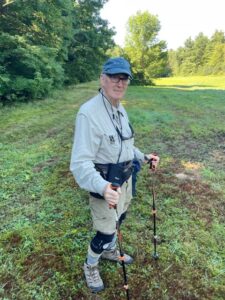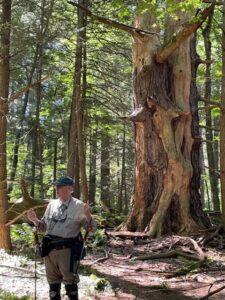The Stockbridge Bowl Association (SBA) was formed on August 30, 1946 in order to protect the natural beauty of Stockbridge Bowl and to set standards that aid the cause of conservation. Today, the SBA pursues the same objectives as at its founding, seeking to protect and preserve the ecological, economic, recreational and aesthetic value of Stockbridge Bowl and the SBA properties, including Bullard Woods and Kwuniikwat Island. It is an all-volunteer organization.
Last Sunday, they met at Bullard Woods to celebrate its 75th birthday and there was a great turnout. Bullard Woods is at the intersection of Hawthorne Road and Hawthorne Street in Stockbridge, across from Tanglewood’s Linde Center. It is comprised of 52 acres of land along Stockbridge Bowl.
Leading up to the event was an exhibit at the Stockbridge Library on June 25, a Beach Island Day with a boat parade on July 16, Annual Meeting with reminiscences on August 6 and an “Old Growth Forest Walk” led by Bob Leverett on this day.
Kicking off the events was Board Member Rick Ruben. “Today is a culmination of a series of events that have been sponsored by SBA.” he said, “One level is to commemorate the SBA 75th anniversary. Another reason is to bring the community close to the lake and to celebrate this resource that we all love and that we have at our fingertips.”
He proceeded to bestow medals on several VIPs for all they do to protect and love Stockbridge and the Bowl.
Stockbridge Selectboard Chairman Patrick White spoke about environmental things the town is working on: culvert repair – part of a municipal grant working with Pittsfield, New Marlborough and Lenox to assess every culvert in town looking for undersized culverts not only for fish to go upstream but also washouts of roads. It is working on a FEMA grant for 900,000 or 90% to fix just one nearby culvert.
The town is working with a climate partners program with the State. They are basically working on how to save our local forests. Some significant problems were discovered with trees at Ice Glen and they were able to treat 50 old growth ash trees through injections and all survived. Hemlocks have been more difficult and are too stressed and damaged to benefit from treatments.
The town is working with State to get charging stations downtown. “It is working hard on climate issues.” he said.
Kevin Foran, better known as “Moose”, who Ruben called “The curator and grounds keeper for nearby Kripalu and also Bullard Woods, super guru and guardian of the Bowl.”
Moose was groundskeeper and supervisor for the properties of the old Shadowbrook Estate for 38 years and has represented Kripalu on the SBA Board for 15 years. He chairs the Property and Trails Committee.
Moose led a hike down to one of the meadows where 2 young pin oak trees were just planted, not far from an older lovely red oak. (Here-to-fore to be referred to as the three sisters).
The first tree was planted in honor of heroes who stepped forward during the covid pandemic placing themselves and families at great risk. Medical professionals, first responders, and the essential workers who played a big part of the supply train that was able to take us through this pandemic up to now.
The second tree honors all the individuals, commissions and committees in the Town of Stockbridge who have dedicated their time to protect the beauty of Stockbridge, who partnered with the SBA in the most beautiful way possible.
Dr. Dan Doyle represented the Berkshire Medical Community. He is director of Pulmonology at BMC and also is the Director of the Public Health Alliance. He referred to a phrase by George Elliot which he interpreted as follows: The strength of a community is powered by community spirit, something that carries on from generation to generation and sustained by the efforts of multiple individuals who help and strengthen it all the time. Bullard Wood and the SBA are certainly examples of that.
Canyon ranch volunteer guides led the way to the meadows. When we got to the new trees, we were encouraged to write messages on bio-degradable paper to the trees to inspire their growth. The messages were buried at the foot of each tree. Plaques were placed under both trees honoring those listed above.
Then the “Old Growth Evangelist” Bob Leverett took over and led the group into the nearby woods to see some old growth trees. Bob Leverett is world renowned, known for his work in locating, identifying and measuring old growth trees. He has been written up in the February 2, 2022 issue of Smithsonian Magazine (where we first saw his title of old growth evangelist.) He was the subject of this column’s March 5-6 issue entitled “They call Bob Leverett “the old growth evangelist.’
When he started hiking the most difficult ridges in Massachusetts he began seeing patches of forests that looked like old forests he saw growing up in the smokey mountains. Bob explained that it has long been believed that old growth forests around here are gone, having been cut down in the 17th century to be used as fuel, fields to farm and timber with which to build. But the loggers missed a few spots over the 300 years, such as areas in Ice Glen Ravine in Stockbridge, the Mohawk State Forest in Rowe, MA, on Mount Greylock and yes, here in Bullard Woods. About 1,400 acres of old growth forest and old growth trees were discovered in MA which could be saved.
“Somewhere along the line someone said you ought to see Bullard Woods,” said Bob, “I came and said this is really great. Not sure what the history is but there are a lot of the original trees in here and it is a hell of a tree growing environment”.
In our walk, we saw oaks and hemlocks 250 years old, a giant white pine over 300 years old. At its last measuring, it was 161 feet high and 13 feet at its trunk, with 1,000 feet of trunk volume. That tree is larger than the famous Monarch pine that grew in Hartly Pine State Park in Michigan. This is one of the great pines in the northeast. We saw a black birch over 200 feet tall, a tulip tree over 100 feet and a very tall shagbark hickory. He referred to the large old trees as “honkers”
Old growth, primary is given to places that were never cleared or logged and exist primarily with the same species that we would have seen in the 1600’s or earlier. They are being impacted for sure, but they also have a certain resilience about them because they have created their environment naturally over several centuries so there is usually a very deep organic layer on the forest floor that deters the invasives. They also are a link to the past. One black gum tree in Orange, MA is 537 years old. A hemlock in Morris Trail State Forest in PA is roughly 500 years old. A lot of old trees are still here scattered around the landscape.”
He talked extensively on the importance of how the old growth trees capture and hold carbon, and even when they fall they release the carbon slowly to the ground.
When asked to define an old growth tree, he said that there is no real definition of how old a tree has to be to be considered an old growth tree. What makes an old growth environment is that it has been controlled by natural processes over several centuries. Whatever you get from that, that’s old growth. There should be in there old trees, certainly older than 250 years or so (if maximum age of the species is about 350). Outside of that we get into deep discussions on how you identify an old growth forest.
“Bullard Woods is not a terribly large forest of old growth trees, but it is quite diverse.” said Moose. “There is something very special about these woods.”. His feelings were summed up by words once written by Robert Louis Stevenson:
“It is not so much for its beauty that the forest makes a claim upon men’s hearts, as for that subtle something, that quality of air that emanates from old trees, that so wonderfully changes and renews a weary spirit.”
